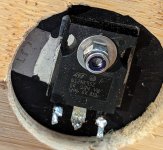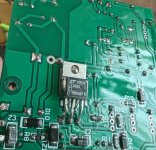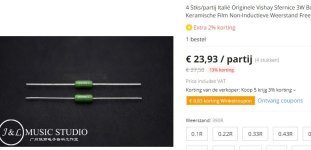Heater wiring done. (PS always handy to post pics. Makes one spot errors. I thought brown black red was 100 Ohm (screen to plate). But it is 1k ofcourse) Better put a 100-200 Ohm in correct?

Answer: To have an external heatsink to house the 21st Century Maida cascode mosfet. (I have a non neurochrome pcb) The board also has a Morgan Jones thingy onboard which I have read many say does the same as two resistors and a capacitor. O well. But it does raise the heater above cathode potential.
It's my first surface mount work..with normal soldering iron...so a little blobby...but it works.

It's my first surface mount work..with normal soldering iron...so a little blobby...but it works.
Attachments
This is why I'm going to use a metal chassis for this build, which I don't usually do. ;-) The chassis will be sufficient heatsink for the Neurochrome board in this case. Kudos on the PCB soldering, though. I could never ever manage that, hence the extra expense of the Maida board.
For anode load Mills 12W, for cathode I use if power needed Mills 12W but if doesn't needs power I use Amtrans AMRG CARBON film or Tants if can afford, bypass cathode resistor BG or Elna Silmic II.Good to have friends!
PS. Cathode bypass caps. What do you guys use? I have panasonic fc and nichicon fine gold in my parts bin with values suitable for this project.
Another favourite pastime: prepping (spent hours trying to find four 15k resistors)View attachment 1153651
Last edited:
I ordered some Ohmite Audio Gold 10W to try as cathode resistor because Mills 12W as become ultra expensive also ordered some for xover tweeter attenuation, for NFB I ordered Vishay CMF55 1% 56k2 & 475k
I don't know if that will help further with suppressing harmonic noise in your build but as G3X is common cathode topology it certainly doesn't need it to avoid breeching heater to cathode max spec. That's useful enough in the cathode follower buffer version.But it does raise the heater above cathode potential.
For sure it is not "needed" but apart from the cathode spec. I did some research...(bathroom type).
Allen Wright when asked why he said this:
"Nope. It is to 'lift' the heaters of the tubes above their cathodes - reverse biasing the inherent 'micro-tube' that exists between the heater and cathode itself and makes a surprising sonic improvent!"
https://www.diyaudio.com/community/thre ... ost-712662
http://www.valvewizard.co.uk/heater.html
"Heater Elevation
Elevation means referencing the heater supply to a DC voltage other than ground or zero volts. The heaters still operate at 6.3V or whatever, but this floats on top of the elevation voltage. Some valve stages such as cathode followers require the heater supply to be elevated to avoid exceeding the valve's Vhk(max) rating. But even when not explicitly needed, elevation can reduce hum in AC-heated circuits by reducing or saturating the leakage current between heater and cathode.* *See: Cooper, C. E. (1944). Valve Hum. Electronic Engineering, (July), pp72-5.
https://audioxpress.com/article/the-int ... cuum-tubes
"Some RCA data books recommend that you make the heater positive with respect to the cathode, ideally by 40 V or so, presumably to minimize noise. So as with everything in life, there are tradeoffs."
But we're dc heating. So might not even reduce noise...
Allen Wright when asked why he said this:
"Nope. It is to 'lift' the heaters of the tubes above their cathodes - reverse biasing the inherent 'micro-tube' that exists between the heater and cathode itself and makes a surprising sonic improvent!"
https://www.diyaudio.com/community/thre ... ost-712662
http://www.valvewizard.co.uk/heater.html
"Heater Elevation
Elevation means referencing the heater supply to a DC voltage other than ground or zero volts. The heaters still operate at 6.3V or whatever, but this floats on top of the elevation voltage. Some valve stages such as cathode followers require the heater supply to be elevated to avoid exceeding the valve's Vhk(max) rating. But even when not explicitly needed, elevation can reduce hum in AC-heated circuits by reducing or saturating the leakage current between heater and cathode.* *See: Cooper, C. E. (1944). Valve Hum. Electronic Engineering, (July), pp72-5.
https://audioxpress.com/article/the-int ... cuum-tubes
"Some RCA data books recommend that you make the heater positive with respect to the cathode, ideally by 40 V or so, presumably to minimize noise. So as with everything in life, there are tradeoffs."
But we're dc heating. So might not even reduce noise...
Roughly 8V across Rk and about 21mA through it. Even if bit more V & mA depending on tube tolerance, Rk will not dissipate more than 0.2W. So 1W is royal margin to never heat up enough. Guarded against extra noise and long time drifting.So perfect for tants....
@Bas Horneman
Yes I mentioned cathode follower and Vhk max too. Certainly not needed in G3X but if silent keep the lift. Maybe there's some side benefit or not.
In any case if there will be hum & buzz disengage the lift and ground the heater return.
Yes I mentioned cathode follower and Vhk max too. Certainly not needed in G3X but if silent keep the lift. Maybe there's some side benefit or not.
In any case if there will be hum & buzz disengage the lift and ground the heater return.
Yeah. I have a nice little 3W Sfernice WW (RB59) . That cost me 30 cent a piece (But even then I was ripped off. Saw them for 15 cents elsewhere). Alixpress is asking 6 euro a piece for!!!We don't need more than 1W power for the 390Ω cathode resistor in the G3X.
 Not sure if exactly the same. B
Not sure if exactly the same. BAttachments
Last edited:
Yes these vitreous enameled are used extensibily in Jadis gears. I use it to set CCS for Salas Bib regs. with great succes.
Should be everything but the dc supply and some hv stuff.
Ps using some generic metal film for the 470k feedback. And had some 56k Takman metal film in my parts box.

Ps using some generic metal film for the 470k feedback. And had some 56k Takman metal film in my parts box.
Last edited:
- Home
- Amplifiers
- Tubes / Valves
- 6V6 line preamp



